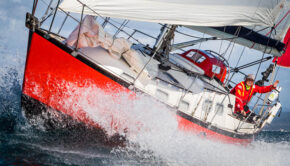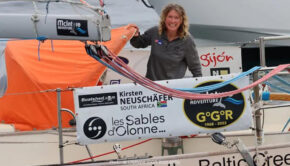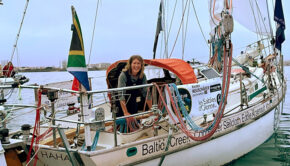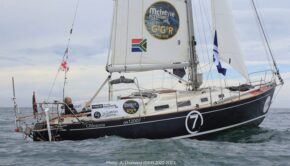Converting Sweat Equity to Cash
Published on September 8th, 2016
To mark the 50th anniversary of the first solo non-stop circumnavigation under sail achieved by Sir Robin Knox-Johnston during the 1968/9 Sunday Times Golden Globe Yacht Race, a new Golden Globe Race is set to start in 2018.
A notable twist to the race format is how entrants are restricted to using the same type of yachts and equipment that were available in that first race. The premise was to keep the race within financial reach of every dreamer, but as Tim Newson has discovered, even frugal dreams have a price tag…
I was concerned last November, when we started this process in earnest, that finding the title sponsor for my Golden Globe Race (GGR) campaign was going to be just too easy. I was actually worried there wouldn’t be any struggle for it; that I wouldn’t experience that anxiety as deadlines passed and I still hadn’t got my boat in the water.
Finding funding is all part of the preparation. In much the same way as a political candidate cut their teeth winning their nomination. If you falter at this early stage it’s a sure sign you’re not going to be able to handle the main event. I didn’t want to miss out on the test.
Well no fear of that! The reason for my naive optimism was that all the other big ocean races are now so expensive. A competitive Vendee Globe or Volvo campaign now costs around £10 million. It’s no longer even viable for big business to be sponsors – they have to team up with private patrons. It’s all got a bit silly, let alone inaccessible.
With the GGR, here is a race with immediate public appeal, a dramatic history, and overall race budgets that are the same as just one carbon foil for a Vendee race boat – around £300k. I genuinely thought they would be queuing up to get their logo on my sail in return for title sponsorship. It was just going to be a matter of making a few calls.
Ten months later, a lot of work tailoring approaches, researching companies, asking everyone that I know who might have a way into a boardroom so I can deliver my pitch, and…nothing. Combined with working on the boat, and a bit of sail instructing, it’s been full time.
I’ve put everything I have into this, and I’ve since borrowed as much as I dared. I’ve written countless letters to wealthy individuals who I thought might be able to help. Today we are no closer to finding a title sponsor for my race and I only have a few weeks left to pay the race fee of £7k, otherwise I’ll lose my place.
We came close. In early May we started negotiations with a City firm that were very enthusiastic. Contracts were being drawn up. I began to hope that we’d finally done it – that the race was on and I was going to get the boat back in the water this summer.
I spent days preparing documents. Then nothing, no communication at all. When I did hear back from them all I got was a casual ‘we might be able to have another look at it in a few months’. It was a sharp reminder of the lack of courtesy so common in big business.
I’ll admit since this setback I have been a little more choosy. Originally I always wanted a company that actually manufactured something – rather than just moved money around – and I decided to stick to this. So I limited my approaches to drinks manufacturers and car makers and businesses that still have some kind of factory.
The race organisers haven’t made it easy for us. We are restricted to a 2 x 1 metre area on the main sail to put our sponsor’s logo on. This really means that we have to find a single title sponsor, or two companies very happy to appear side by side (yes – I’ve exhausted all Gin & Tonic companies). Although this has made it difficult it means the GGR race boats aren’t floating billboards – so I find it hard to really disapprove of this rule.
So why hasn’t it happened? What’s the feedback from my approaches? Well two reasons are mostly given. The first is the economy. The EU referendum has meant that for much of the time I have been making approaches there has been unprecedented uncertainty about the long term stability of the UK economy. Uncertainty that has only heightened since the Brexit vote. This really has been an especially difficult environment to be asking for sponsorship.
Then there is the event itself. Although many people remember the original 1968 race and will no doubt follow this new incarnation it remains an unknown quantity. It’s not like the Vendee or the Volvo with a clear track record and actual media stats. The GGR hasn’t been held for fifty years. The boats aren’t high tech – it’s all low tech. It ain’t flash – it’s slow – we’re at sea for nine months travelling at 5 knots. It’s all a bit quirky. Quirky for boardrooms tends to equal risky.
It’s a shame – I believe it is an opportunity lost – this race is about the long haul, about not giving up. It’s about perseverance and building a boat and a skipper that can last for almost a year non-stop at sea. It’s got some brilliant values that I really thought the right kind of business would want to identify with.
Perhaps the problem is that it isn’t going to be very exciting – apart from the the few uncomfortable days when we are stuck in a storm. But this is also a virtue – in this way the GGR is much like everyday life, albeit one with a lot of hard graft and loneliness. To conceive of it in any other way would be psychologically risky for the entrants – 9 months is too long to be doing this on adrenaline.
Does failing to find a title sponsor mean the end for my campaign? Certainly not. Like all good sailors I have a contingency plan. It’s called the Labour Exchange and it’s all off my own back. After all isn’t being self sufficient what this race is all about? No point in waiting for a handout in the middle of the Southern Ocean. I only have a few weeks left so the pressure is on! This is the kind of test I was always after.
Editor’s note: If you made it to the final paragraph, be sure to click on the Labour Exchange link. We’re pretty sure you have never heard an idea like this one.










 We’ll keep your information safe.
We’ll keep your information safe.